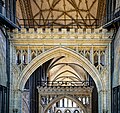
A strainer arch (also straining arch) is an internal structural arch built to relieve the inward pressure off the spanned vertical supports (providing a "buttress", thus also called buttressing arches), usually as an afterthought to prevent the supports from imploding due to miscalculation. In the past they were frequently adorned with decoration, with one of the best examples provided by Wells Cathedral. Strainer arches can be "inverted" (upside-down) while remaining structural.
The typical construction of Romanesque and Gothic churches includes east-to-west arcades, where each arch is buttressed by its neighbours. The issue at the east end is resolved using the buttressing of an apse to the choir, while at the west end a massive "westwork" is used. In a large church a similar problem occurs at the crossing, where the arcades of the nave and choir have to terminate. A "spectacular" solution for the crossing buttressing issue at Wells Cathedral was found by William Joy (1338, 17 years after completion). A similar arrangement was added to both crossings of Salisbury Cathedral more than 100 years after the completion of most of the building, but shortly after the addition of a tower (1380). The straining arches were added in the east-west direction, thus being unobtrusive when viewed from the nave. The arrangement at the east crossing (built in 1388) is similar to the one at Wells, while the great crossing uses a single-arch strainer design. In Bristol Cathedral the strainer arches are used to carry the thrust from the central vault over the aisles, as in this hall church building the width of the aisles is half that of the nave, therefore the transverse forces cannot be balanced in an arcade-like fashion.
-
 Pillars at the crossing of Salisbury Cathedral bending due to insufficient buttressing
Pillars at the crossing of Salisbury Cathedral bending due to insufficient buttressing
-
 Strainer arches in the great crossing of the Salisbury Cathedral
Strainer arches in the great crossing of the Salisbury Cathedral
-
 Strainer arches in an aisle of the Bristol Cathedral
Strainer arches in an aisle of the Bristol Cathedral
-
 Buttressing arches in Bonifacio, Corsica
Buttressing arches in Bonifacio, Corsica
See also
- Flying buttress, an outside arch built to relieve the horizontal thrust
- Girder, a horizontal support beam
- Flying arch, used in sites such as railway cuttings
References
- "straining arch". Merriam-Webster.com Dictionary. Merriam-Webster.
- "Strainer arch". canterbury-archaeology.org. Canterbury Historical and Archaeological Society. Retrieved 4 March 2024.
- Woodman & Bloom 2003, Inverted.
- Woodman & Bloom 2003, Strainer.
- Heyman 2015, p. 9.
- Heyman 2015, p. 10.
- Heyman 2015, p. 11.
- Heyman 2015, p. 13.
Sources
- Heyman, Jacques (2015). "Strainer arches". Construction History. 30 (2). The Construction History Society: 1–14. ISSN 0267-7768. JSTOR 44215905. Retrieved 2024-03-03.
- Woodman, Francis; Bloom, Jonathan M. (2003). "Arch". Oxford Art Online. Oxford University Press. doi:10.1093/gao/9781884446054.article.t003657. ISBN 978-1-884446-05-4.
This architecture-related article is a stub. You can help Misplaced Pages by expanding it. |